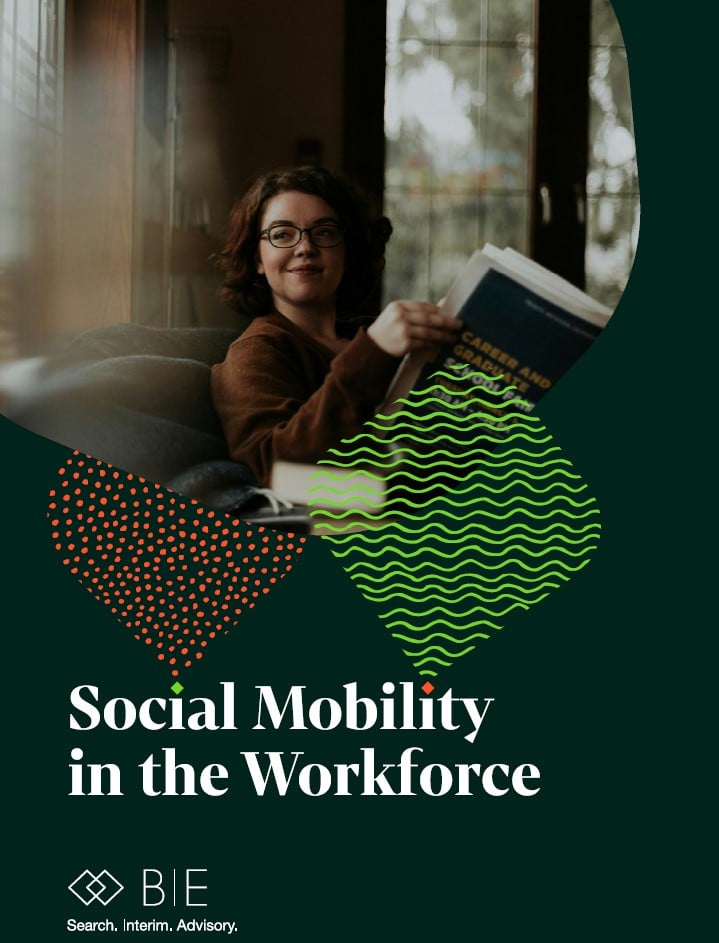
It’s not hard to see why. People are the greatest asset of any organisation, and while diversity is about bringing more voices to the table (across race, sexual orientation, age, religious beliefs and more), inclusion is important in making sure they stay.
Businesses across the UK are making ED&I a priority and progress is being made, supported by the 2010 Equality Act. However, there are diversity issues that fall outside the remit of the law. Social mobility, for example, is an important facet of ED&I, but can be a blind spot for organisations.
The UK’s Social Mobility Commission defines social mobility as “the link between a person’s occupation or income and the occupation or income of their parents.
Where there is a strong link, there is a lower level of social mobility. Where there is a weak link, there is a higher level of social mobility.” In essence, it’s about a person’s chances of movement, either up or down, in terms of their circumstances in comparison to those of their parents. “Social mobility has become the term we use to describe awareness and action on socio-economic disadvantage,” explains Sarah Atkinson, CEO of the Social Mobility Foundation.
It is a feature of every developed economy in the world. The 2020 Global Social Mobility Index from the World Economic Forum concluded that the majority of the 82 economies benchmarked (the UK is ranked 21st) are “failing to provide the conditions in which their citizens can thrive,” meaning that “an individual’s opportunities in life remain tethered to their socio-economic status at birth, entrenching historical inequalities.”
Improving social mobility is about tackling these inequalities and removing barriers to allow people to succeed. According to Joanne Conway, Head of Diversity, Equity & Inclusiveness at EY UK, “there are training tools but it ultimately it comes down to behaviour – constantly looking at how decisions are made and also looking at the data.”
Data shows that employees from lower socio-economic backgrounds perform at least as well as their more advantaged peers, if not better. Mixed teams are more creative and resourceful than narrow teams. Greater socio-economic diversity offers competitive advantage.
“It is fundamental that any action to improve social mobility comes from the top,” said Justin Rix, Partner at Grant Thornton UK LLP.
“It’s not just about saying the right words. Leaders have to take accountability that things will change, and that they are committed to delivering it. That’s where it starts.”
Jasmine Song, Head of Inclusion at SHL, agreed: “It’s like with D&I more generally – many businesses view it as something to help them function better, or become more profitable. And while that is one lens, it’s also about transforming peoples’ lives through employment, and helping them flourish into their best selves.”
In addition to driving change at an organisational level, engaged leadership can indeed enact significant change on an individual level. The sharing of stories and, in the process, normalising the social mobility conversation is a powerful tool. Organisations should consider establishing platforms to foster involvement with social mobility efforts, and encouraging participation from those who feel comfortable sharing their experiences.
It’s also important that organisations invest in leadership development so that leaders, from the CEO to line managers and mentors, have the tools and skills required to support the team appropriately.
Data is another powerful tool to help you understand your organisation and implement a diversity strategy.
Using data, you can map socio-economic background objectively. Everyone has a socio-economic background, meaning that you can measure it and define it. This data maps clearly against opportunities that people will have in their education and careers, so you know where a person is on that scale. However, there is a subjective measure to take into account as well, and that’s social class. It brings in things around identity, accent, culture and place, which are emotive. If you’re having a conversation about creating an inclusive environment in terms of social mobility, you have to be open to this part of the conversation as well.”
Armed with the right data you can effectively target, implement and track social mobility change in your organisation, and measure the success of your policies. You can also evaluate your efforts against national benchmarks, and those for your industry.
Measuring your socio-economic diversity is critical to driving success. The Social Mobility Commission’s Employers’ toolkit sets out its recommended questions to ask and why, how to analyse and interpret results, and comparing results with benchmarking data.
The toolkit recommends asking questions – respectfully and confidentially – about three key areas to get the information you need from your current and new employees: parental occupation; the type of school they attended; and free school meal eligibility (crucially the eligibility for it, not whether or not the scheme was used).
If you’re only asking one question when you collect data, Sarah Atkinson recommends asking the parental occupation question (Question 1 below). Based on this advice, this is the question that we at BIE ask all shortlisted candidates to complete on our ED&I Diversity Monitoring Form.
The Sutton Trust provides the following explainer which you may wish to include with these questions:
Our organisation is committed to ensuring everyone has the opportunity to succeed, regardless of their background. Research shows that someone’s socio-economic background (the social and economic circumstances a person grew up in, including the social class and financial resources of their family, and the type of school they attended) can sometimes disadvantage them in the workplace. We want to understand more about this issue in our workforce, so that we can remove any barriers, open up opportunities within our organisation and ensure we are making full use of the talent available.
This is the best measure we have to assess someone’s socio-economic background. Not only that, but it’s easy to understand, it gets the highest response rates in testing, and it’s applicable to those of all ages and from all countries.
Report socio‑economic background in 3 groups, following this guide:
Review the proportion of applicants and staff members from each socio-economic background – is there equal or close to equal representation from each group? If not, which is the dominant socio-economic group?
You can compare your results to the national benchmark below which sets out what percentages of each of the socio-economic background categories (professional, intermediate and working class background) are found in the working population (age 16+).
You can compare your results to the following UK national benchmark: 7.5% attended independent schools.
You can compare your results to the following national benchmark:15% of pupils at state-funded schools are eligible for free school meals.
You can compare your results to the national benchmark: 49% of graduates are first in family to attend university.
Any journey to improve social mobility involves the examination of any possible bias, unconscious or otherwise.
You might, for example, consider your internship programme to be inclusive, but if it’s unpaid and in a major metropolitan centre, like London, you are most likely excluding applicants from a low socio-economic background.
According to the Sutton Trust, a leading organisation in the social mobility space, 70% of internships are unpaid, thereby “locking out young people who cannot afford to work for free.”
“There are specific barriers that people from low socio-economic backgrounds experience – some hard and some soft – and experience consistently. We have to make sure our focus is on changing the barriers in their way, not changing the people who are going to come through them,” explains Sarah Atkinson.
It’s also important to change systems and processes to create equity within an organisation. According to Joanne Conway, when a person starts in a junior position it’s often about the technical skills and the knowing ‘how’, which is more evenly distributed. As they move up through the organisation, it is knowing the ‘who’ and knowing the ‘why’. But if there are not processes in place that lead to equitable outcomes, if they don’t have access to non-technical information through their network, it can place the employee at a disadvantage.
“We have to make sure our focus is on changing the barriers in their way, not changing the people who are going to come through them.” Sarah Atkinson, CEO, Social Mobility, Foundation
Improving social mobility involves opening up your company to the best people, regardless of their background.
Removing qualification barriers is key as qualifications can often exclude disadvantaged applicants who may not have had the best opportunities but who can thrive in your organisation. Justin Rix’s company, Grant Thornton, for example, removed the academic entry requirements for its entry-level schemes – thereby removing a hiring practice that might discriminate against disadvantaged applicants who might not have had the opportunity to attend university. “We’ve got nothing against grads applying, but we want to make sure we’re open to a much broader range of people,” he explained. “We wanted to level the playing field in terms of where people start from, and it’s worked. We went from 90% graduates and 10% school leavers split, to more like 50/50.”
Jasmine Song also recommends that you “look for potential, not polish when hiring. And evaluate achievements in the context they were achieved. Not all achievements are equal, even if they might look that way from the outside.” Looking at skills, rather than just qualifications, for example, could help you identify promising candidates who might look less qualified on paper.
The Social Mobility Commission recommends ensuring hiring practices are accessible and equitable to all applicants by taking the following steps, some of which are more appropriate to school and education leavers, while others remain relevant for people at all levels:
“Looking at skills, rather than just qualifications, for example, could help you identify promising candidates who might look less qualified on paper.” Jasmine Song, Head of Inclusion, SHL
As the Social Mobility Commission stresses: “socio-economic inclusion is not just about who gets in, it’s also about who gets on.” Be sure to examine your requirements for career progression, as well as recruitment.
Employee data can help identify if there are levels within your organisation that people from lower socio-economic backgrounds do not reach. Regular performance reviews and discussions about career progression, as well as opportunities for further training, can also help with this.
As Justin Rix explained: “It’s one thing to get a more diverse range of people into your business, another thing to make them feel welcome and keep them in the business. You have to make sure your business is somewhere they want to be, and can be themselves.”
Taking action on social mobility doesn’t have to involve a massive budget and a grand plan from the outset – improvement begins with a few small steps, and you can take it from there.
You can download a PDF of this report by clicking here.
Social Mobility Commission: Socio-economic diversity and inclusion: employer’s toolkit
Social Mobility Commission: State of the nation 2021 (social mobility and the pandemic)
Social Mobility Foundation: Social Mobility Employer Index
Making the Leap: UK Social Mobility Awards
The Sutton Trust: Social mobility in the workplace: an employer’s guide
World Economic Forum: Global Social Mobility Index 2020
If you would like any assistance with making your hiring processes fully inclusive, from resources to hands-on guidance, please contact our ED&I Lead Eoin Canty and he will be happy to advise you.
